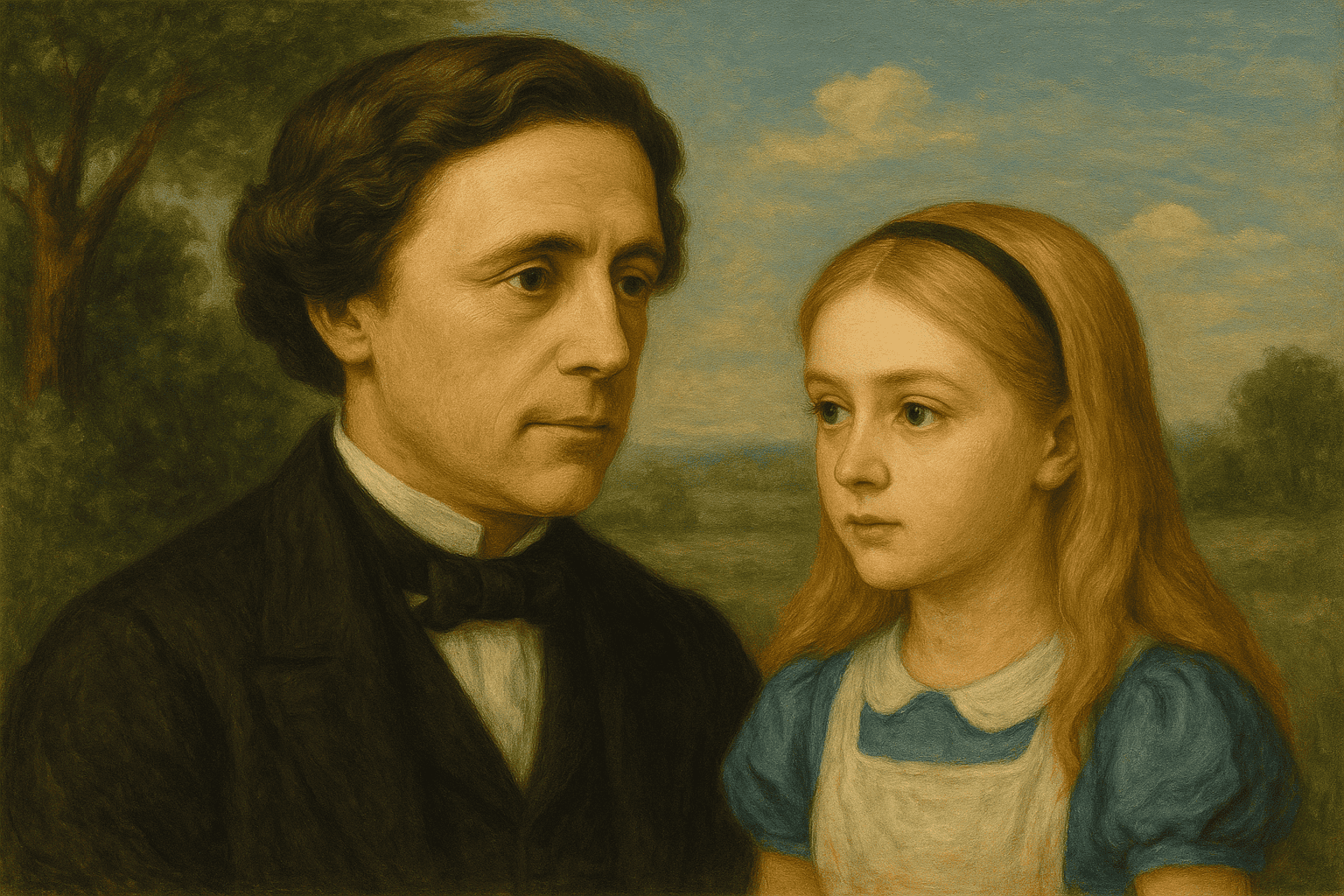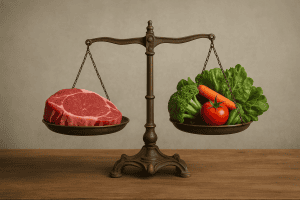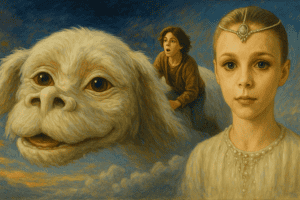Part I – The Descent: Through the Rabbit Hole
“The cave you fear to enter holds the treasure you seek.” — Joseph Campbell
Victorian England liked its worlds tidy: the church explained the soul, the crown explained order, and logic explained everything else.
Into that precise geometry stepped a mathematician who whispered a dream that refused to stay symmetrical.
Charles Dodgson — Lewis Carroll — lived inside the system’s cathedral of reason, yet his imagination slipped through a crack in its marble floor and fell into mystery.
When he wrote of a girl chasing a white rabbit, he was tracing the oldest story of all: the soul leaving heaven to wander the labyrinth of illusion.
The Moment of Fall
A bright afternoon, a drowsy riverbank, a book with no pictures — and boredom, that subtle summons to curiosity.
Alice’s attention catches on a small impossibility: a rabbit in a waistcoat, muttering about time.
She follows, and the world gives way.
In that single motion — from the familiar into the impossible — Carroll sketches the first act of the Gnostic myth: Sophia’s curiosity, her desire to know the source of all things, pulling her from the fullness (Pleroma) into the hollow reflection (Kenoma).
The rabbit hole is not merely an entrance but a vortex.
Walls spin with clocks, cupboards, and maps; order collapses into motion.
This is how descent feels from within — not punishment but the vertigo of awakening inside limitation.
Time begins its rule; gravity becomes law; the infinite contracts into the measurable.
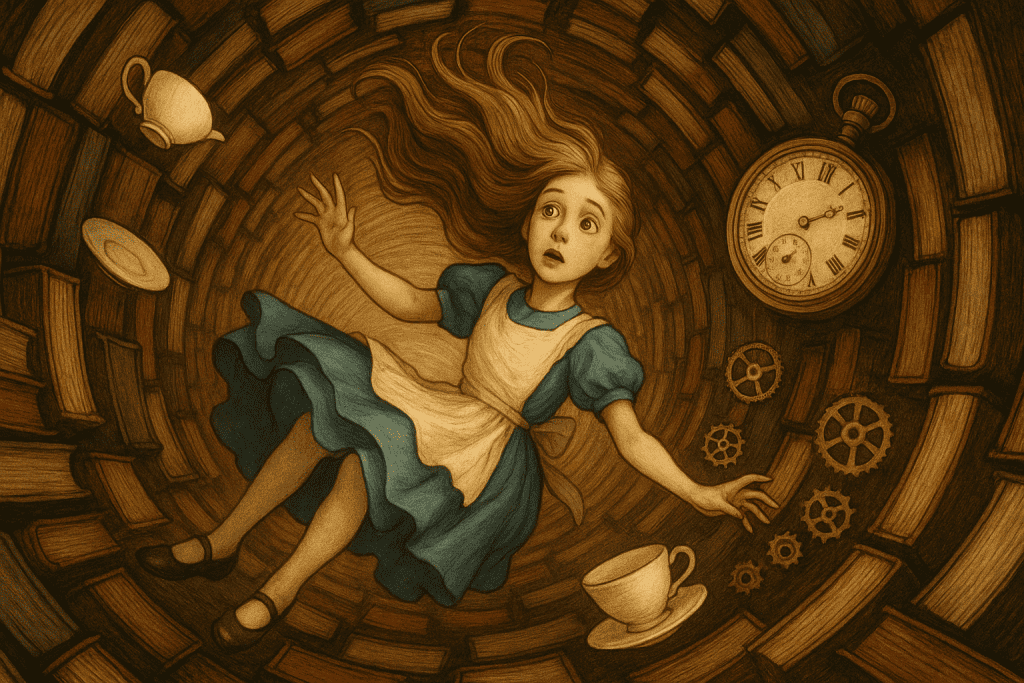
The White Rabbit: The Servant of Time
The White Rabbit is the herald of the Demiurge’s domain.
He is obsessed with lateness, with the ticking that divides eternity into anxious fragments.
Every “I’m late!” is the cry of a being trapped in chronos — the horizontal time of decay.
Yet it is his panic that guides Alice onward; illusion itself becomes the teacher.
So too in the soul’s journey: what first appears as distraction or error is often the hand of destiny disguised in absurdity.
Carroll, the mathematician of time and measure, understood this irony.
By chasing the clock, one enters the dream where the clock loses meaning.
The White Rabbit leads not only Alice but every reader into the mirror of their own conditioning.
The Corridor of Doors
At the bottom of the fall, Alice finds herself in a hallway lined with locked doors of every size.
Upon the glass table lies a tiny golden key.
This is initiation.
The soul, newly embodied, perceives countless forms yet cannot pass through until it discovers the correct proportion of being — the key that matches awareness to form.
The “Drink Me” bottle and the “Eat Me” cake alter her size wildly, illustrating the confusion of identity within incarnation: too vast for the body, too small for the world.
Knowledge — the tasting of experience — must be balanced before the door can open.
When at last she adjusts herself and glimpses the garden beyond, we recognize the distant memory of the Pleroma: a vision of harmony glimpsed but not yet entered.
Descent as Divine Error
In the language of theology, Sophia’s fall was a mistake; in the language of myth, it was a necessity.
So too with Alice.
Her curiosity breaks the surface of ordinary consciousness; her fall is the price of knowing.
Carroll understood this paradox intimately — a clergyman who could not wholly believe, a logician who found truth in nonsense.
Through Alice he dramatized the soul’s secret hunger to pierce the veil, even if it means tumbling through darkness.
Every reader who follows her performs the same act.
To open the book is to lean over the riverbank of one’s own certainty and drop into reflection.
Reading becomes the modern form of descent — literacy as initiation, imagination as the ladder back upward.
Transition to the Realm Below
As Alice passes the tiny door at last, the narrative tone itself changes: speech distorts, meanings double, authority becomes absurd.
She has crossed into the Demiurge’s playground, a world that imitates creation but cannot sustain coherence.
The next chapters will show how that counterfeit order operates — and how awareness, once ignited, can navigate its madness.
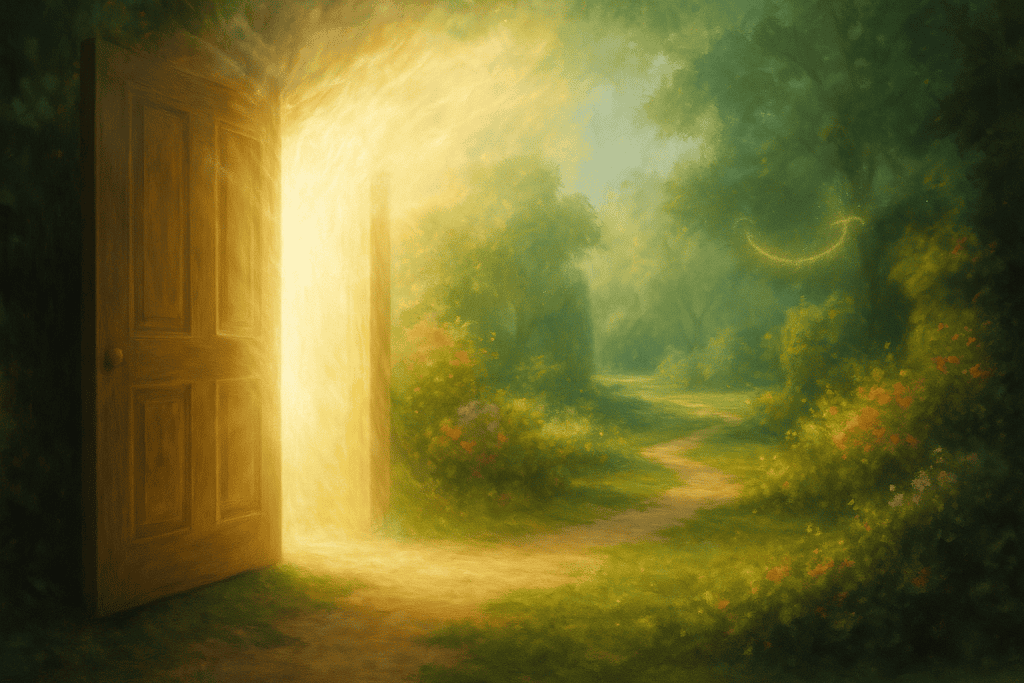
Part II – The Realm of Confusion: Wonderland as the Demiurge’s World
When Alice steps through the small door, proportion, reason, and grammar fracture.
What had been a world of sunlight and rivers becomes a landscape of contradictory rules.
This is the Kenoma, the counterfeit creation that imitates life but has no center.
Everything in it strives to appear meaningful; nothing within it truly is.
The Language of the Archons
In Wonderland, sentences chase their own tails.
Questions never receive answers; words change meaning as soon as they’re spoken.
This is not childish nonsense — it is a portrait of the Archons’ speech, the chatter that fills the lower world.
Carroll, master of logic, shows how reason itself can become a maze when divorced from wisdom.
The logic of the Demiurge is precise but hollow: it convinces without enlightening.
Each paradox and pun is a mirror in which the reader sees language undoing itself.
The Caterpillar – The Questioner
Amid the chaos, a still point: the Caterpillar upon his mushroom.
Smoke drifts like the breath of contemplation.
He asks a single question: “Who are you?”
In that question lies the entire path of gnosis.
Alice cannot answer.
She has changed size so many times that “I” no longer feels solid.
This is the soul’s crisis — the loss of identity within form.
The Caterpillar does not console her; he reflects her confusion back until she begins to see it.
He offers a piece of the mushroom, instructing her to taste carefully.
Knowledge, Carroll suggests, is always double-edged: one bite enlarges, another diminishes.
Only balance — self-knowledge tempered with humility — opens the way forward.
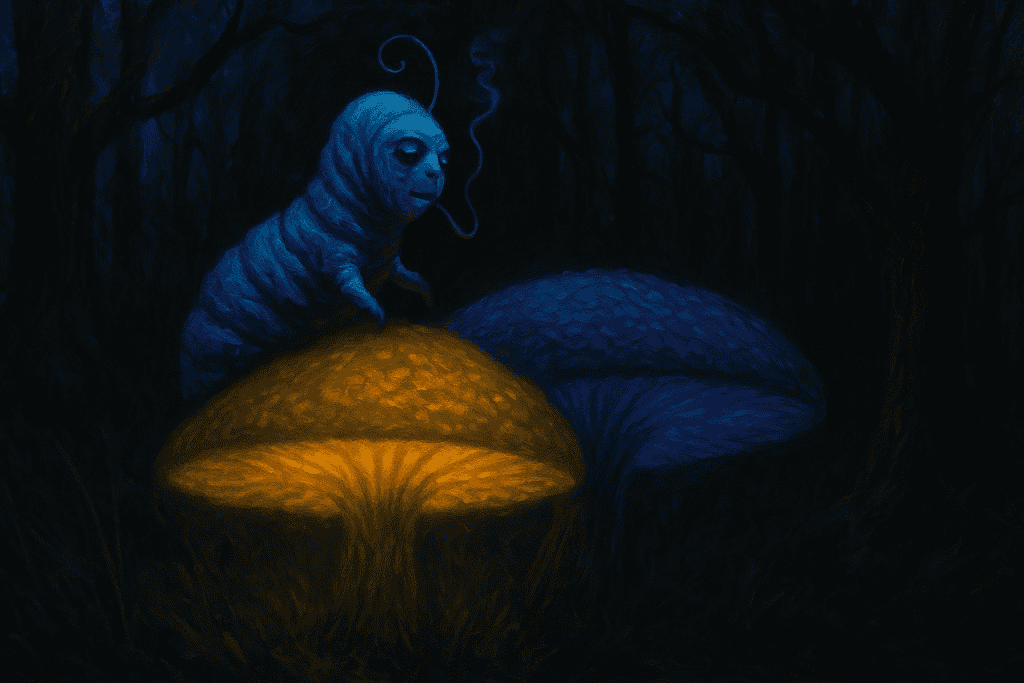
The Mad Hatter’s Tea Party – Time in Chains
Next comes the strangest feast in literature: endless tea.
Time itself has broken; it is “always six o’clock.”
The Hatter, the March Hare, and the Dormouse circle through meaningless ritual, eternally waiting for a moment that never comes.
This is chronos without kairos — time without revelation.
Carroll, who lived by timetables and cathedral bells, intuited the horror hidden in the clock: repetition mistaken for life.
The tea party is the church of habit.
Everyone speaks; no one listens.
Cups change places; meaning does not.
Alice’s irritation is sacred: it is the beginning of discernment.
To tire of the endless chatter of the Archons is to sense that another rhythm exists — the still pulse of eternity behind the ticking.
The Cheshire Cat – The Spark That Smiles
From a branch above the road, a grin appears before a body.
The Cat speaks in riddles yet seems to understand more than anyone else.
He appears and vanishes at will; his smile lingers when everything else dissolves.
This is the divine spark, consciousness that persists beyond form.
He tells Alice that everyone in this land is mad — including her.
It is both warning and blessing: awakening begins with admitting that the world’s sanity is insanity.
The Cat’s disappearing act teaches the nature of spirit.
Form may fade, but awareness remains.
Even in the darkest dream, something smiles.
That smile is the trace of the Real.
The Queen of Hearts – The False Sovereign
Finally, Alice meets the ruler of this realm: a woman whose power depends entirely on fear.
Her favorite command — “Off with their heads!” — reveals her purpose: to sever consciousness from spirit.
She is the Demiurge in a red dress, the ego that sustains illusion through violence and decree.
Her kingdom is populated by playing cards — two-dimensional beings performing roles without depth.
This is how false power maintains itself: by surrounding emptiness with ritual.
Yet the Queen is terrified.
Every outburst masks the dread that her world is unreal.
When Alice refuses to cower, the Queen’s authority trembles.
Recognition — not rebellion — unravels the Archon’s control.
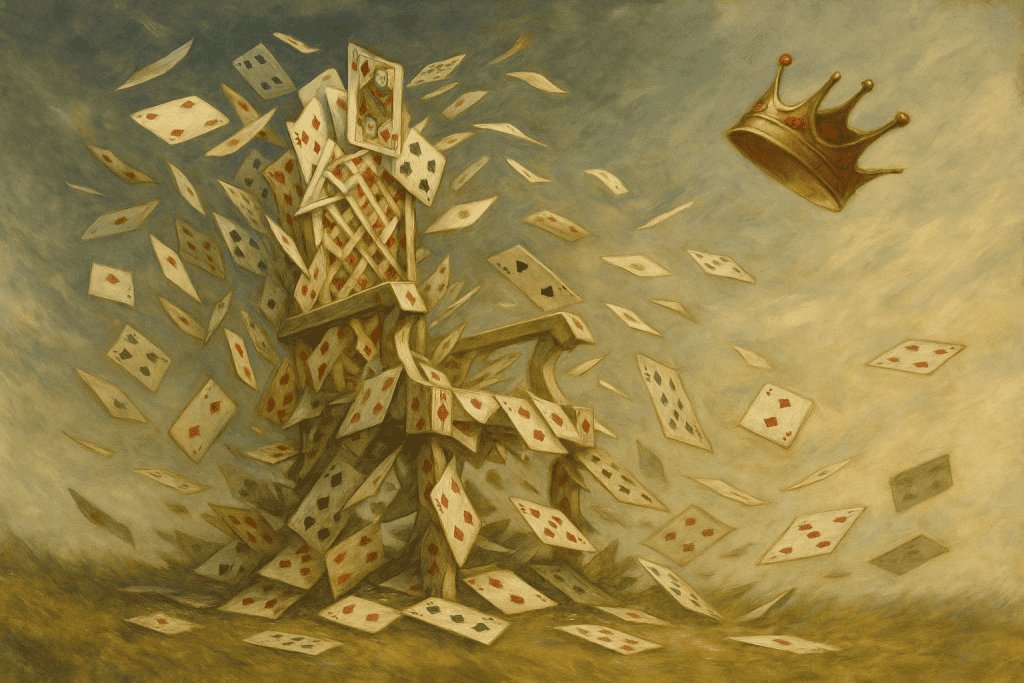
Toward the Awakening
By the time the trial begins, Wonderland is already breaking down.
The courtroom, like all false worlds, collapses under its own absurdity.
When Alice grows to her full size, the illusion cannot contain her.
She names the truth aloud — “You’re nothing but a pack of cards!” — and the dream shatters.
That sentence is gnosis.
Seeing through is liberation.
The rest is awakening.
Part III – Hints & Keys: Reading Wonderland Symbolically
In every mirror, a second world waits for those who know how to look.
1 · Begin with Feeling, not Analysis
When the story confuses you, pause inside that confusion.
Carroll’s nonsense isn’t a puzzle to be solved; it’s a field of vibration meant to loosen ordinary logic.
Let bewilderment itself become the teacher—Gnosis often arrives as wonder disguised as chaos.
2 · Every Character is a Fragment of the Self
- White Rabbit – the anxious pulse of time within you, forever rushing toward nothing.
- Caterpillar – the still voice that asks, Who am I? and waits while you learn to answer.
- Cheshire Cat – your witnessing awareness, smiling even when the body and story fade.
- Queen of Hearts – the frightened ego that rules by shouting; meet her with calm, not battle.
- Alice – the spark of innocence wandering through its own dream.
When you reread, watch how these figures move inside you rather than around you.
3 · Language as Spell and Key
The Archons rule through words that hypnotize.
Carroll turns that weapon back upon them: puns, riddles, reversals.
Each time language collapses, truth peeks through the gap.
Read aloud—the sound of sense breaking is part of the initiation.
4 · Size Shifts = States of Consciousness
Growing and shrinking mark the soul’s oscillation between pride and humility, matter and spirit.
The work is to find the “right size”: awareness vast enough to see, small enough to love.
5 · The Mushroom of Knowing
Half expands, half contracts.
Knowledge inflates when grasped by ego, liberates when held lightly.
Taste slowly.
6 · The Tea Party and the Clock
Whenever life feels like “always six o’clock,” step outside repetition.
Silence resets time; presence breaks the loop.
Meditation is leaving the table.
7 · The Trial and the Wake-Up
The world judges before it listens.
Your liberation begins the moment you notice the absurdity.
Name it—a “pack of cards”—and the illusion loses power.
8 · Return with Vision
Alice wakes beside the river; the dream dissolves but awareness remains.
To wake is not to escape but to carry clarity into the ordinary day.
After every descent, bring back a little more light.
9 · How to Read the Book Now
- Read it aloud once for the child within.
- Read again slowly, letting each absurdity mirror something familiar.
- Then close your eyes; let the images rearrange themselves inside you.
That third reading—the one behind the eyelids—is the real journey.
Before saving, open your browser’s print dialog and turn off Headers and footers (the title and URL line).
Chrome / Opera / Edge: Menu → Print → uncheck Headers and footers • Firefox: More settings → turn off Print headers and footers • Safari: already clean
